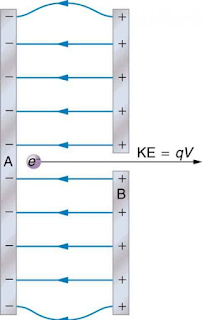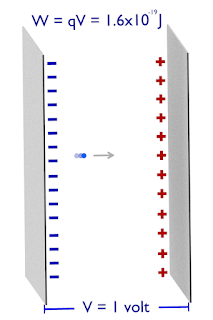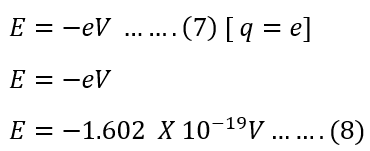- Definition of Electron Volt: An electron volt (eV) is the energy required to move a single electron through an electric potential difference of one volt.
- Power Calculation: Electrical power (W) is calculated by multiplying voltage (V) with current (I).
- Energy Expression: The energy (in joules) of a charge is calculated by multiplying the charge (q, in coulombs) by the voltage (V).
- Charge of an Electron: Each electron has a charge of -1.6 × 10⁻¹⁹ coulombs.
- Applications of Electron Volt: Electron volts are used to measure energy at atomic and electronic levels and are also applied in thermal and light energy calculations.
In atomic and nuclear physics, the electron volt (eV) is widely used as a practical unit of energy. While the joule is the standard SI unit, it is often too large for representing the very small energy scales typical of electrons and other subatomic particles.
An electron volt (eV) is a smaller unit of energy, ideal for measuring the energy of subatomic particles like electrons, protons, and ions.

Definition of electron Volt(eV)
One electron volt (eV) is defined as the amount of work done when an electron moves across an electric potential difference of one volt. This unit effectively measures very small amounts of energy, which are common in atomic and nuclear physics.

Symbol and Value of Electron Volt
The symbol for electron volt is eV. One eV equals 1.602 × 10⁻¹⁹ joules in the SI system. This value comes from multiplying the charge of one electron (1.602 × 10⁻¹⁹ coulombs) by a potential difference of one volt.
Why Electron Volt is Used Instead of Joule
The electron volt is preferred over the joule when dealing with subatomic particles because it avoids extremely small decimal numbers, making calculations and comparisons much simpler in particle physics and quantum mechanics.
Practical Examples of Electron Volt
Electron volts are commonly used to express the energies of particles and photons in physics:
- Energy of visible light photons: ~1.65 to 3.1 eV
- Ionization energy of a hydrogen atom: 13.6 eV
- Kinetic energy of electrons in CRT screens: a few thousand eV (keV)
These examples show how the eV unit is practical for describing microscopic energy scales in quantum mechanics and particle physics.
Derivation of Electron Volt(eV)
When voltage is applied to an electric circuit, current starts flowing according to the circuit’s resistance or impedance. Let the voltage applied be V and the current flowing in the circuit be I.
The power drawn by the circuit is;

The current in the circuit is equal to the rate of transferring the q charges from the lower to the higher potential point.

Putting the value of equation(2) in equation(1), we get

The energy is the capacity to do work. The energy is the power integrated over time.

Putting the value of power Equation(3) in Equation (4), we get

Therefore,

The charge Q coulomb travels against an electric field of voltage V, then the work done by the charge is – QV.
Quick Reference: Electron Volt (eV) and Joule Conversion Formulas
| Formula Recap for Electron Volt Conversions | |||
| Quantity | Formula | Unit | Example Value |
| Electron Volt | eV = e × V | Joules | 1 eV = 1.602 × 10⁻¹⁹ J |
| Joule to eV | eV = J / 1.602 × 10⁻¹⁹ | eV | 1 J = 6.242 × 10¹⁸ eV |
Calculation of eV from Voltage and Charge
If the electron crosses the electric field of 1 volt, the work done is equal to ;

eV Joule Conversion
eV and joule are units of energy used in two different measurement systems.
To convert electron volts to joules, use the formula:
Energy (J) = Energy (eV) × 1.602 × 10⁻¹⁹
Where,
- eV is electron volt
- J is Joule
The table below shows the conversion of energy from electron volts (eV) to joules (J):
| Energy in eV | Energy in Joules |
| 1 eV | 1.60218×10-19 J |
| 2 eV | 3.2044×10-19 J |
| 3 eV | 4.8065×10-19 J |
| 4 eV | 6.4087×10-19 J |
| 5 eV | 8.0109×10-19 J |
| 6 eV | 9.6131×10-19 J |
| 7 eV | 1.1215×10-18 J |
| 8 eV | 1.2817×10-17 J |
| 9 eV | 1.442×10-18 J |
| 10 eV | 1.6022×10-18 J |
| 50 eV | 8.0109×10-18 J |
| 100 eV | 1.6022×10-17 J |
| 500 eV | 8.0109×10-17 J |
| 1000 eV | 1.6022×10-16 J |
Multiples and Submultiples of Electron Volt
The electron volt (eV) is often expressed using larger or smaller multiples depending on the scale of energy being measured. This approach helps avoid long strings of zeros and makes communication clearer in scientific contexts.
Common multiples include:
- 1 neV (nano-electron volt) = 10⁻⁹ eV — used in ultra-low energy physics such as precision atomic measurements.
- 1 peV (pico-electron volt) = 10⁻¹² eV — relevant for extremely low-energy quantum systems.
- 1 keV (kiloelectron volt) = 10³ eV — common in X-ray physics and electron microscopy.
- 1 MeV (megaelectron volt) = 10⁶ eV — widely used in nuclear physics and radioactive decay studies.
- 1 GeV (gigaelectron volt) = 10⁹ eV — frequently used in high-energy particle physics experiments.
- 1 TeV (tera-electron volt) = 10¹² eV — applicable in particle accelerators like the Large Hadron Collider (LHC).
These multiples cover a broad range of energies from the tiniest quantum scales to the extremely high energies encountered in astrophysics and particle physics.
History of Electron Volt
The concept of the electron volt emerged in the early 20th century as physicists began exploring the atomic and subatomic world. Around this time, scientists were conducting experiments involving electron beams and particle collisions that required a convenient way to measure very small amounts of energy.
The joule, while the standard SI unit of energy, was too large to effectively represent these tiny energy scales. To overcome this, the electron volt was introduced as a practical unit defined by the energy gained by a single electron moving through a potential difference of one volt.
This new unit quickly became popular because it simplified calculations and communication in atomic, nuclear, and particle physics. Since then, the electron volt has been a fundamental measurement unit, used widely in research, industry, and education related to quantum mechanics, spectroscopy, and high-energy physics.
Real-Life Applications of eV
- Medical Imaging: Used to measure X-ray and gamma-ray photon energies in CT scans, PET scans, and radiation therapy for accurate diagnosis and treatment.
- Spectroscopy: Helps determine electron binding energies in techniques like photoelectron spectroscopy and X-ray absorption spectroscopy.
- Astrophysics: Measures high-energy cosmic ray particle collisions, aiding in the study of black holes, supernovae, and gamma-ray bursts.
- Semiconductor Physics: Evaluates bandgap energy of materials to design solar cells, LEDs, and semiconductor devices.
- Nuclear Physics: Determines reaction thresholds, decay energies, and binding energies in nuclear reactions.
- Particle Physics: Expresses the energy of particles in accelerators like the Large Hadron Collider (LHC), where energies reach into the tera-electron volt range.
Conclusion
The electron volt (eV) is a practical unit of energy in atomic, nuclear, and particle physics. It provides a convenient way to measure the extremely small energies of subatomic particles, where using joules would be impractical.
Knowing its definition, formula, and conversion to joules helps in understanding concepts from photon energy to high-energy particle collisions.
Whether in quantum mechanics, nuclear research, or astrophysics, the eV remains an essential unit for describing energy on the microscopic scale.
Frequently Asked Questions(FAQs)
Electron volt is a unit of energy, not voltage. It measures the amount of kinetic energy gained or lost by an electron moving through a potential difference of 1 volt.
Multiply the value in eV by 1.602 × 10⁻¹⁹ to get energy in joules.
Because particle energies are extremely small, using joules would lead to inconvenient decimal values. eV makes calculations and comparisons easier.
1 eV = 1.60218 × 10⁻¹⁹ joules, the energy an electron gains when accelerated through 1 volt.
Related Articles: